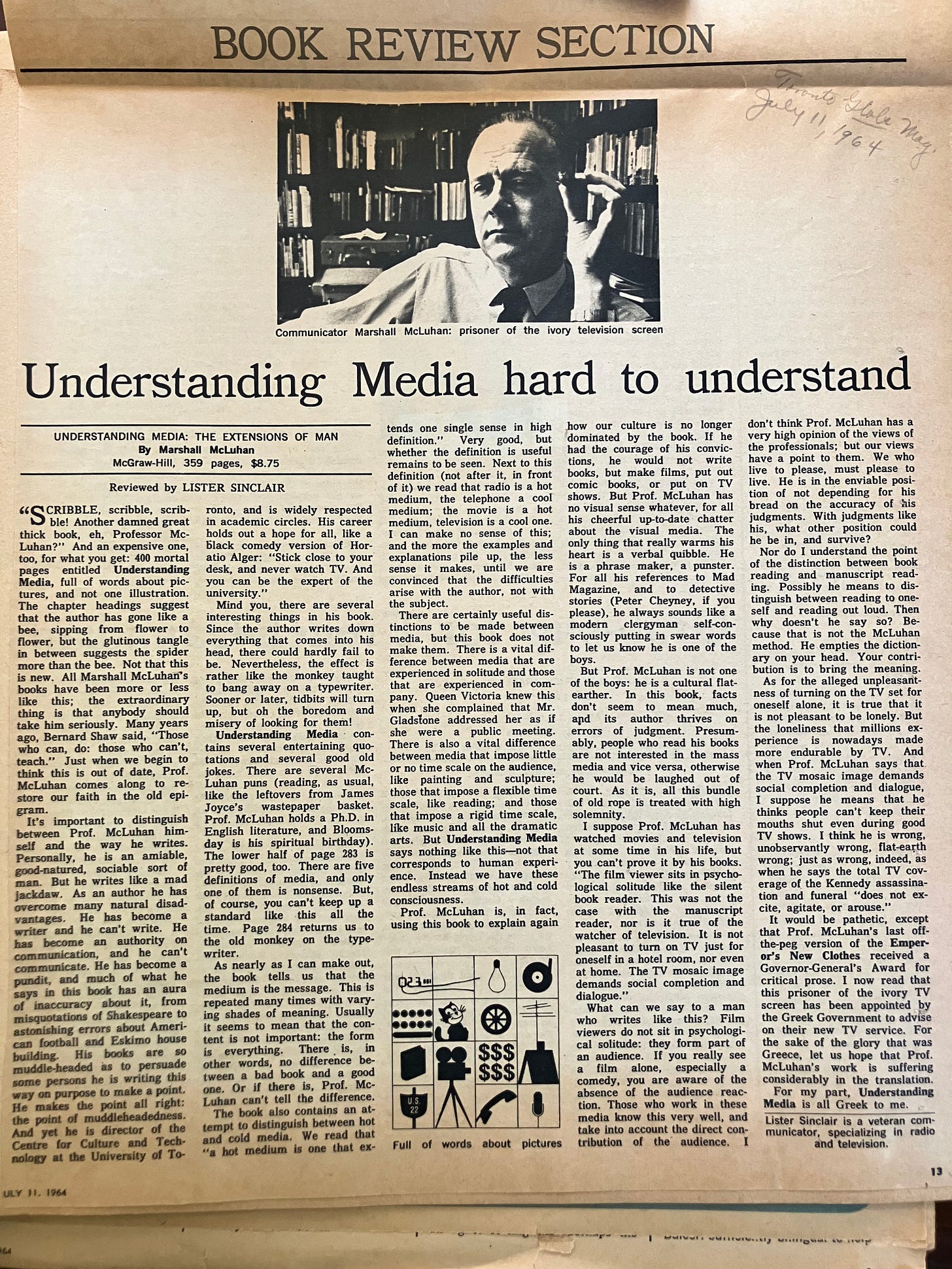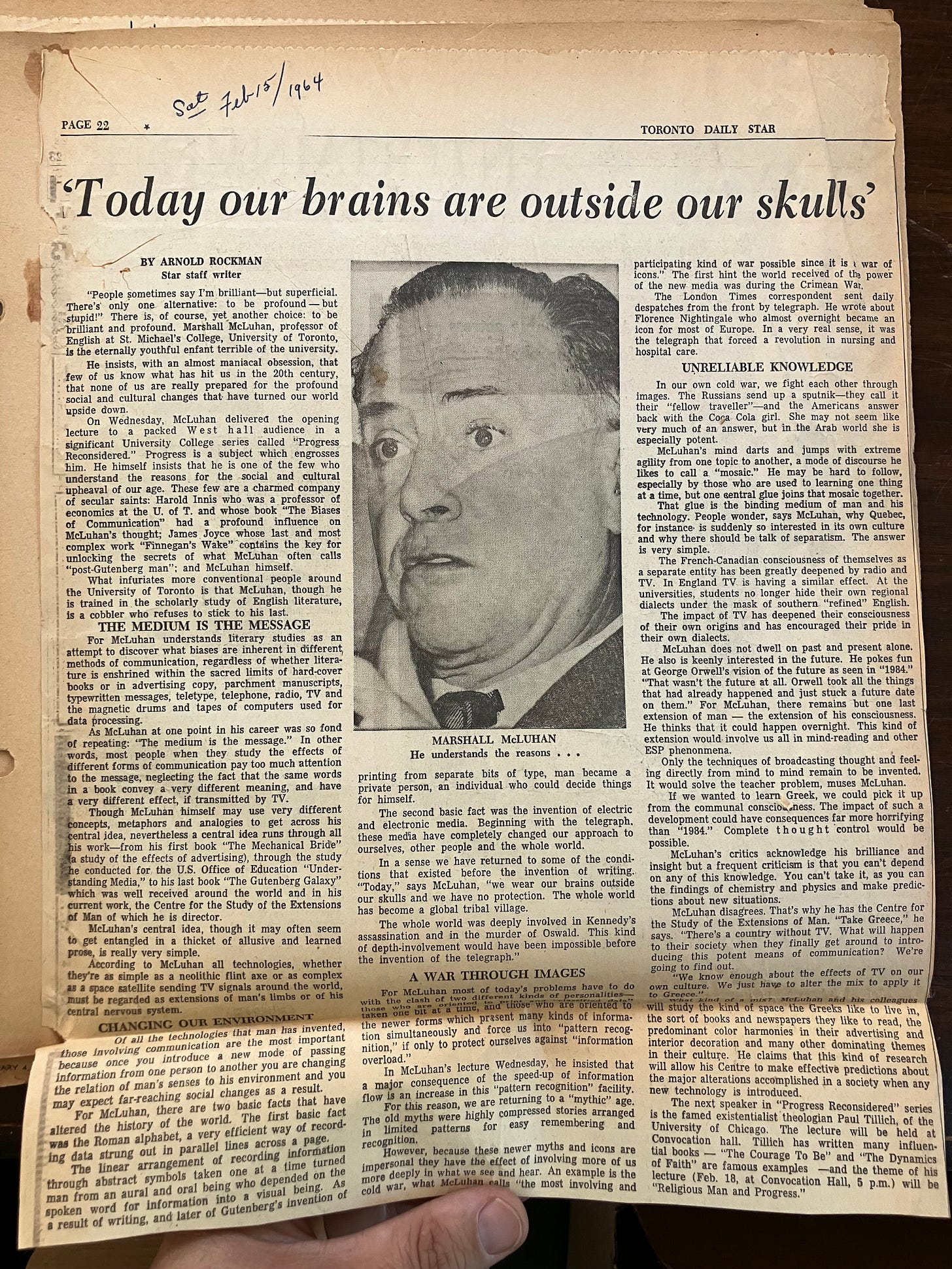Reading, and Understanding Media
A guidebook, and poetry more than prose, Marshall McLuhan's 1964 work remains one of our best resources for exploring the nature and effects of new media. It's not an easy read, so I'm going to help.
“I don’t explain, I explore”

Sixty years ago, Marshall McLuhan published ‘Understanding Media: The Extensions of Man.’ The book upset many people, delighted others. Among many, people like Umberto Eco and Lester Sinclair dismissed it, while others like Tom Wolfe and Howard Gossage praised it.
Whether for or against, it seemed that it was a work to be reckoned with, as evidenced by the very many reviews pro and con which appeared. It was even featured in a magazine ad for Jantzen sweaters – and you know you’ve hit the zeitgeist when…
A few weeks ago, my teaching assistant (who had taken my UMI course before) Joseph Reid said “talk about burying the lede” when Marshall waited until page 76 (I ususally cite from the 2003 ‘critical edition’) to state:
“The present book, in seeking to understand many media, the conflicts from which they spring and the even greater conflicts to which they give rise, holds out the promise of reducing these conflicts by an increase of human autonomy.”
‘Hybrid Media: Les Liasons Dangereuses.’ (UM, chapter 5)
I’ve spent the last four years diving deeply into it with about 150 others over two complete readings (and now into the third group) and want to share some (maybe most) of what I’ve learned with you.
I should begin by stating my interest and approach.
Marshall McLuhan would say from time to time that he was not so attached to any of his ideas that he wouldn’t leave one behind the moment it outlived its usefulness.
“Concepts are very provisional affairs for apprehending reality; their value is in the grip they provide… ideas are very secondary devices for clambering up and over rock faces.” Preface to ‘The Mechanical Bride: Folklore of Industrial Man.’
My own interest in my family’s work is largely practical: I am primarily interested in what methods my grandfather Marshall and father Eric developed for ‘understanding media’ which can be used today and tomorrow. Anything else is, for me, secondary.
I have, these last few years, focused on ‘Understanding Media’ because I believe it’s the most accessible of the McLuhan works. It is also, I have come to find, a very practical guide – though it takes a lot of work to make use of it. Frankly, it takes more work than most people are willing to put in. I’m not sure that’s a failing of the author: the point of ‘Understanding Media,’ like most of McLuhan work, is not just to teach you but to train you. You don’t, presumably, go to the gym and expect the trainer to lift the weights for you. It is, however, nice to have some direction rather than just show up and be expected to figure it all out for yourself. With regards to the book under discussion, and the day, some amount of help is required.
Marshall comes hot out of the gate with his object and with a definition in the very title of his book.
His object: understanding media. It implies that media can be understood and that the book is a means to that end. If the book requires much of its reader, it is because the subject does. Marshall was keenly aware of the difficulty (folly) of trying to fit the subject into the form of a book. It is why the book was crafted the way it was – and that subtlety was and is lost on many. Marshall doesn’t make it any easier by giving you plain statements or advice. You are left, as I was, to figure it out for yourself. But I will, over the next months, save you all kinds of trouble by giving you the benefit of my explorations and experience.
“All media are extensions of some human faculty- psychic or physical.”
– The Medium is the Massage (1967)
A definition of media: extensions of man. Actually, the book’s title is an indication of the work required by the reader. Understanding media, as a pursuit, begins with understanding that all our media, our technologies, are extensions of some part of ourselves. This, Marshall believes, is the first thing to understand about the nature and effects of media. Not that he is the first person to notice this.
“The human body is the magazine of inventions, the patent-office, where are the models from which every hint was taken. All the tools and engines on earth are only extensions of its limbs and senses.” Ralph Waldo Emerson, 1870
Eric McLuhan stated something to the effect that ‘the body is the etymology of technology.
A key method of ‘understanding media’ in the McLuhan tradition is: by examining the nature of the form, you can gain insight into the nature of the effect, and that the place to begin in examining the nature of the form is by tracing it back to its human origin.
[This notion of ‘extension’ or ‘amplification’ gets deeper treatment in ‘Laws of Media: The New Science,’ a book or project begun in the early 1970s by father and son as a new edition of Understanding Media, finally completed by Eric McLuhan and published in 1988 through University of Toronto Press.]
Elsewhere I’ve described how in ‘An Historical Approach to the Media’ in 1955 Marshall wrote that
“Improvements in the means of communication are usually based on a shift from one sense to another and this involved a rapid refocusing in all previous experience. It is, therefore, a simple maxim of communication study that any change in the means of communication will produce a chain of revolutionary consequences at every level of culture and politics. And because of the complexity of the components of this process, prediction and control are not possible.”
Only to state a few years later that
“But increased awareness of the forms of the media as they operate on the modes of perception and judgement, is not merely a means of understanding, but of prediction and control. Awareness of media itself is a change and a cause of change.” ‘Project in Understanding New Media’ 1960
What was responsible for his changed views on media? That change of heart and mind fascinates me. It was the result of his gaining a grant from the National Association of Educational Broadcasters, the ‘Project in Understanding New Media’ which resulted in McLuhan’s so-titled 1960 report. It was to be a curriculum for high school kids but didn’t seem to go anywhere at all.
Marshall (McLuhan? Grandad?) had spent the better part of two years in deep research of the nature and effects of human innovation. This effort had resulted in such dramatic personal shifts in awareness and understanding that he changed his opinion from media being so complex as to be impossible to predict and control, to a completely opposite view.
///
In approaching Understanding Media, it helps to have a lot of context. When I teach my course ‘Understanding Media Intensive’ I spend the first two sessions (sessions tend to run 2-3 hours, one a week) looking at Marshall McLuhan’s background. Who he was, how he came to write the book. It’s impossible to compress that all down to a few sentences but the basics are: Marshall McLuhan was a lover of literature, as well as a teach of it his entire career, the bulk of that at the University of Toronto. He never stopped teaching English even while his side hustle of exploring media took off. The fact that he was trained in literary criticism is not a merely a curiosity but is an important fact – his work in understanding media is a direct result of his training in literary criticism. Simply put, he ported the skills from literature to media.
The first major piece of advice I give to people reading Understanding Media is to treat it more like a book of poetry than a book of prose or non-fiction. The reader of those different forms has different expectations.
With poetry, you get out what you put in.
When you read a poem you expect to do a lot of work in order to get a lot of benefit. You expect to read it more than once, maybe in more than one way. You expect layers of meaning.
If you start to read the book with these things in mind, you will get a lot out of it.
///
Another tip I have, though this will be a tough one for most, is that if you’ve read it before, give it another shot.
I tried to read Understanding Media as a teenager, and didn’t get a lot out of it. I tried again in my 20s, and got a bit more (but not nearly as much as I thought I did). In my 30s is when it started to click.
I have also read it cover to cover extremely deeply over the last four years and gotten more every time. Not only more out of the text, but more out of today: the book is designed to help us understand the present, and as our present is being continually reshaped by each successive technology, the book bears re-reading or re-application.
It’s amazing, but this book was specifically designed to help us understand our present and continues to do just that.
///
Over the next many months I am going to do a series of newsletters (I try to get at least one a month out) giving my sort of Cole’s Notes to Understanding Media. I’d love to do a book on it but… as Lamartine said at the advent of the newspaper,
‘the book arrives too late.’
We desperately need to change our collective conversation around technology and its effects. I am doing all I can to aid that. I believe it was Einstein who said that the definition of insanity was to keep doing the same thing but expect different results – it’s time that those in charge understood ‘the medium is the message.’
///
Shoutouts: back in fall 2020, when I set out to do the first version of ‘Understanding Media Intensive,’ Barry Threw, executive director of Gray Area (SF) was quick to offer help. They have since helped me lead groups through two full readings of Understanding Media – each one is about 36 2-3 hour classes, taking about 18 months to get through cover to cover. We’re now in our third group. It’s been about 150 people from around the world from all walks of life and I’m grateful to Barry, Gray Area, and all the people who have gone through this with me.
I also really appreciate all of you readers and subscribers of The McLuhan Newsletter. Thanks for being here and giving me more reasons to do this work.
*note that all posts are free. No paywalled content here. If you’re able to do a paid subscription, I appreciate it. If not, or no longer, no worries.





One reason I like his writings is that it is sort of a hybrid between the spoken word and the written word. I love the audio version of The Medium is the Massage. Linguists and phenomenologists make a distinction between spoken and written language that I think is worthy of some conversation. This conversation is pointing to a growing awareness of the differing effects of image-based and oral-based communication. The medium differences between social media and direct conversation is a growing topic of discussion in my world. What do think your dad and granddad would say about this?